|
ARBOR Technology FPC-9002-P6
Machine Vision Controller with Intel Xeon E3 or 6th and 7th generation Core processors, PCIe expansion slots, and half a dozen Ethernet-powered LAN ports
(by Conrad H. Blickenstorfer; photography by Carol Cotton)
Share on:




This report is about ARBOR Technology's FPC-9002-P6, a robust Box PC targeted at machine vision applications. The FPC-9002-P6 was introduced mid 2018 as an addition to ARBOR's growing number of FPC series rugged, modular industrial PCs.
The FPC-9002-P6 offers plenty of onboard connectivity, a choice of Intel 7th generation "Kaby Lake" processors, as well as a workhorse Xeon option. What sets the PPC-9002-P6 apart from standard box PCs is that it is configured to meet the demands of industrial machine vision applications. This includes half a dozen 802.3af-compliant PoE (Power-over-Ethernet) ports for use with GigE Vision cameras, dual PCIe expansion slots (x16 and x8), as well as RAID 0/1 support for extra performance via striping or reliability via mirroring.
The FPC-9002-P6 is fairly compact for a IPC in this class, measuring 8.86 x 11.50 x 4.72 inches and weighing about 15 pounds. This makes it suitable for applications where space is at a premium.

ARBOR calls the FPC-9002-P6 a "dedicated machine vision controller." How is that different from a standard industrial PC? Sitting side-by-side with one of ARBOR's FPC-7900 Series Box PCs, they seem almost identical, sharing design, housing, and most I/O. What does set them apart is that the FPC-7900 Series offers balanced I/O and maximum configurability in order to cover a wide range of industrial applications. The FPC-9002-P6, on the other hand, is tailored specifically to one type of applications — machine vision.
What is machine vision, and what are its special requirements? Machine vision refers to the use of cameras to optimize industrial processes that require visual assessment. High-speed cameras are used to monitor and record production processes. Computers then perform real-time analysis of captured data, flagging items and taking appropriate action. Modern machine vision systems must be capable of capturing complex situation visuals and process large amounts of data for two or even three-dimensional analysis.
The requirements for a machine vision controller therefore include a) direct, reliable, high speed connection to multiple cameras, b) sufficient processing power to perform real-time data analysis, c) sufficient storage for vast amounts of data, and d) onboard expansion connectivity for application specific third-party interface cards and modules.
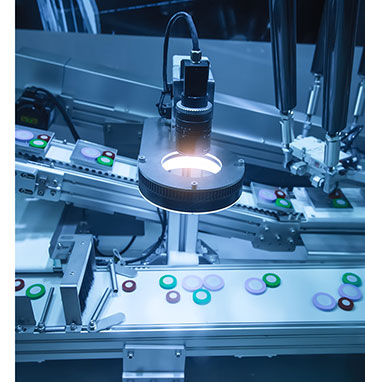 Increasing use of machine vision — Early examples of machine vision applications were in printed circuit board production, inspection of labels and alignment, and other tasks machines could perform faster and with more accuracy than human operators. More recently, machine vision advanced to recognizing and interpreting symbols and entire labels. Increasing use of machine vision — Early examples of machine vision applications were in printed circuit board production, inspection of labels and alignment, and other tasks machines could perform faster and with more accuracy than human operators. More recently, machine vision advanced to recognizing and interpreting symbols and entire labels.
Today, machine vision is widely adopted in industrial automation and manufacturing, with applications ranging from optical inspection of goods such as semiconductors or solar panels, to postal and parcel sorting, robotics management, industrial X-rays, food packaging, and clean room operations. In that capacity, machine vision applications, aided by rapid advance in artificial intelligence provisions, are increasing quality, productivity, and safety.
Why power over Ethernet? — Most machine vision cameras or radar sensors are very compact, small enough to be installed wherever they need to be. This makes using individual power supplies problematic. USB is possible as it can carry power, but cable length and wattage is limited.
The answer is supplying power directly over Ethernet. PoE combines data communication and power into one single cable, allows longer cable lengths, and provides up to 15 watts to each device (see PoE wiki).
So what must the ARBOR FPC-9002-P6 be able to do to be part of machine vision solutions? It must communicate with multiple cameras at high speed while supplying them power at the same time; it must have enough onboard connectivity to not only communicate with the cameras, but also numerous state-of-the-art as well as legacy devices; it must have enough processing power to handle all that communicating and all required machine vision processing; it must support the IEEE 1588 Precision Time Protocol that is used to synchronize clocks throughout a computer network; it must support the GigE Vision interface (see GigE Vision wiki); and it must do all that in a reasonably small and compact package.
Design and construction of the ARBOR FPC-9002-P6 series
ARBOR describes all of their FPC series of industrial PCs as "robust" rather than "rugged." That's largely a matter of semantics as both terms imply toughness and heavy-duty construction. 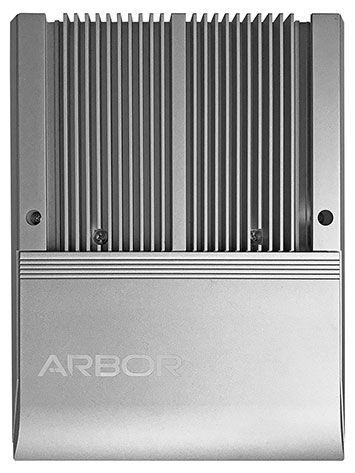 But whereas in mobile systems, "rugged" generally means protection against the elements, drops, scratches, and remaining functional under extreme conditions, in industrial PCs, "robust" means heavy, durable build, utmost reliability, and ease of maintenance and reconfiguration.
But whereas in mobile systems, "rugged" generally means protection against the elements, drops, scratches, and remaining functional under extreme conditions, in industrial PCs, "robust" means heavy, durable build, utmost reliability, and ease of maintenance and reconfiguration.
As a result, industrial PCs usually have a strong steel chassis to mount the electronics on, and heavy, ribbed aluminum housings that serve as heat sinks and spreaders. IPCs are heavy (because weight doesn't matter as much in fixed-mount systems), easy to access and service (there are no complex seals and miniaturized integrated modules and components), and there are no fans (fans are noisy, dust magnets, and prone to failure).
The FPC-9002-P6 is a primary example of that type of construction. There's a steel chassis, front and back plates with all the necessary cutouts for ports, and then the heavy aluminum top and bottom parts of the housing that collect and dissipate the heat. It's all held together by perhaps a dozen easily accessible screws.
In IPCs, everything is neatly labeled and easy to figure out. There is far more connectivity than in any home or business desktop PC, but also far less open space for large numbers of extra drives or other components. This helps IPCs be more compact and less cluttered than reglar PCs.
As for the difference between the FPC-790X Series of Box PCs we reviewed in detail late 2017 and the new FPC-9002-P6, there's very little. The motherboard is the same, as is the overall onboard connectivity concept. What sets the FPC-9002-P6 apart is that it has been configured specifically for the needs of machine vision applications.
Here is what the FPC-9002-P6 looks like from the front and from the back:

Below you can see what it looks like inside. On the left is a view of the bottom of the FPC-9002-P6's internal steel chassis with its vertical riser card that can accommodate two PCI or PCIe cards. On the right is the same steel chassis viewed from the top.
Note the two fans. With the FPC-790X Series, fans are an option only required for use with the most powerful of the available processors. The FPC-9002-P6 comes with the fans regardless of the processor option. And thanks to Smart Fan support, cooling is actively managed to offer both peak performance and maximum efficiency.
The FPC-9002-P6 can accommodate two SATA SSDs, an internal one that's fixed-mounted for security reasons, and an externally accessible one that's easily swappable. Systems with dual SSDs can be configured to work in RAID 0 (striping for extra performance) or RAID 1 (mirroring) mode.
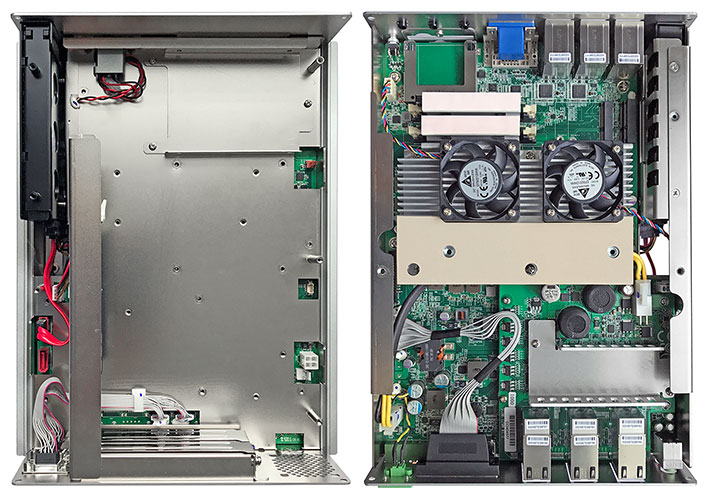
Other helpful design features: The FPC-9002-P6 comes with a built-in super capacitor CMOS so that users can replace the (externally accessible) RTC battery without losing any settings.
I/O galore
Although the ARBOR FPC-9002-P6 is an industrial computer targeted at a very specific application — machine vision — different machine vision applications will still the presence of all typical industry standard I/O ports.
So ARBOR equipped the device with three regular Ethernet RJ45 jacks to allow connection to multiple networks. There are six fast USB 3.0 ports for general connectivity. Two DB9 serial ports cover legacy connectivity. Both are configurable to RS-232/422/485. A DB25 connector can be used either for digital I/O or as a legacy LPT port. Four different video standards are supported (VGA, DVI-D, HDMI, and DisplayPort), and the system can drive three independent displays. There's a watchdog timer, audio in and out, and also optional WiFi, GPS, or 3G/4G broadband via mPCIe modules:
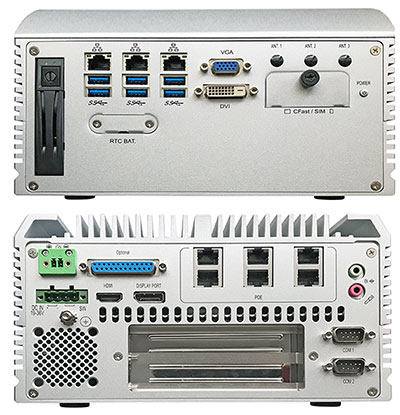
- 6 x USB 3.0/2.0 ports
- 1 x 15-pin VGA video
- 1 x DVI-D
- 1 x HDMI
- 1 x DisplayPort
- 1 x CFast
- 1 x SIM card slot
- 3 x RJ-45 gigabit LAN
- 6 x RJ-45 for Power over Ethernet
- 3 x pass-through antenna
- 2 x Serial RS232/422/485
- Audio line-in and line-out
- 1 x DB25 connector for DIO or LPT
- Power (19~36 Volt DC from adapter)
- 2-pin terminal block for ignition switch
A wealth of processor options with emphasis on performance per watt
While customers demand the latest processors in consumer market PCs, there is much less such pressure in industrial market box PC to always get the latest and greatest. What matters is that the job gets done reliably and economically. That doesn't mean, however, that industrial customers don't care. If the latest technology is available, then that's certainly an extra incentive to buy.
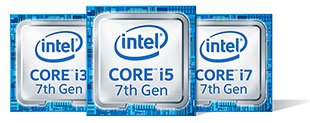 ARBOR is aware of that and offers a very attractive set of processor choices for the FPC-9002-P6 machine vision controller. All but one of them are members of Intel's "Kaby Lake" 7th generation Core processors. ARBOR is aware of that and offers a very attractive set of processor choices for the FPC-9002-P6 machine vision controller. All but one of them are members of Intel's "Kaby Lake" 7th generation Core processors.
What does Kaby Lake bring to the table and why is it important? Efficiency. Performance per watt is what matters, and each new processor generation does better than the prior one thanks to clever new power-saving techniques and by continuously shrinking the size of the transistors that are the basic building blocks of a microprocessors. 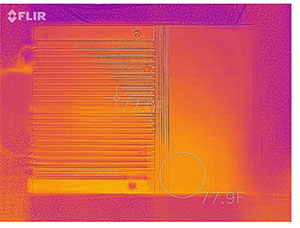 In Kaby Lake the distance between two transistors is an incredibly small 14 nanometers, and that is as good and efficient as it currently gets. That's why the latest chips can provide the most performance in a given size package that can dissipate so and so much heat. In Kaby Lake the distance between two transistors is an incredibly small 14 nanometers, and that is as good and efficient as it currently gets. That's why the latest chips can provide the most performance in a given size package that can dissipate so and so much heat.
The orange/red picture to the left is an infrared images taken with our lab's FLIR One Pro thermal camera. We used it to see how much the FPC-9002-P6 heated up when we put a heavy load on it. The answer: it hardly heats up at all. Between the large passive heatsinks and the smart cooling fans, heating up simply isn't an issue. The Smart Cooling system continually adjusts fan speed, allowing peak performance without running the fan at speed when that's not needed.
So now let's take a look at the processors ARBOR offers with the FPC-9002-G6. That'd be four different 7th generation Core processors, one each from the i3 and i7 lines, and two i5 variants. There's also a 6th generation Xeon chip option, with Xeons generally known as heavy-duty server CPUs (some say Xeon chips are to Core chips like Diesels are to gasoline combustion engines, with the Xeons excelling at handling sustained, heavy load).
The table below shows some of the pertinent specs of the available processor options:
|
ARBOR FPC-9002-P6: Available Intel processor options (Click for full spec table)
|
|
CPU Type
|
Core i7
|
Core i5
|
Core i3
|
Xeon
|
|
Model
|
7700T
|
7500T
|
7101TE
|
E3-1268L v5
|
|
Code
|
Kaby Lake (7th gen)
|
Kaby Lake (7th gen)
|
Kaby Lake (7th gen)
|
Skylake (6th gen)
|
|
Lithography
|
14 nm
|
14 nm
|
14 nm
|
14 nm
|
|
Cores/Threads
|
4/8
|
4/4
|
2/4
|
4/8
|
|
Base Clock Speed
|
2.90 GHz
|
2.70 GHz
|
3.40 GHz
|
2.40 GHz
|
|
Turbo Speed
|
3.80 GHz
|
3.30 GHz
|
no turbo
|
3.40 GHz
|
|
Thermal Design Power (TDP)
|
35 watts
|
35 watts
|
35 watts
|
35 watts
|
|
Smart Cache
|
8MB
|
6MB
|
3MB
|
8MB
|
|
Integrated graphics
|
HD Graphics 630
|
HD Graphics 630
|
HD Graphics 630
|
HD Graphics P530
|
|
Graphics base speed
|
350 MHz
|
350 MHz
|
350 MHz
|
350 MHz
|
|
Graphics max speed
|
1.15 GHz
|
1.10 GHz
|
1.10 GHz
|
1.00 GHz
|
|
Intel vPro
|
Yes
|
Yes
|
No
|
Yes
|
|
EEC memory support
|
No
|
No
|
Yes
|
Yes
|
|
T-Junction
|
80°C (176°F)
|
80°C (176°F)
|
88°C (190°F)
|
unknown
|
Now let's briefly discuss these processor options.
By and large, Intel's i3/i5/i7 nomenclature represents "good/better/best" which in processors is measured in performance and baked-in features. But note this:
- Three of the four Core chips have a "T" designation. That means they are "power-optimized," i.e. they run slower and cooler than they theoretically could, which means greater longevity.
 - The Core i3 7101TE is the low man on the totem pole. It doesn't have turbo speed and it's missing some of the Intel features a customer may or may not need. The "E" in its designation usually means "Embedded," and that may mean extended processor availability. Also note that this i3 chip costs just a fraction of the high-end i7, so overall system price should be quite a bit lower.
- It's more difficult to assess the pros and cons of the Xeon processor option. It's a quad-core design with eight threads (like the i7 option), with the major difference being support for EEC memory. EEC stands for error-correcting code, so if absolute freedom from memory errors is a must, getting a chip that supports the slower and more expensive EEC type of RAM may be a must. And there's another thing: since the Xeon E3-1268L v5 is part of the Intel "Skylake" 6th generation of processors, it can run Windows 7 whereas Kaby Lake-baed unit need to use Windows 10.
So there are important considerations when deciding what sort of processor to use in a Box PC, and ARBOR is wise enough to offer cleverly selected options.
What performance can FPC-9002-P6 customers expect? A lot.
Ideally, we would have been able to test FPC-9002-P6 units with each of the five processor options, but we cannot expect manufacturers to make that much gear available. As is, our review FPC-9002-P6 came with the Core i7-7700T. For comparison, we added the very similar ARBOR FPC-7901 Box PCs we've recently tested, as well as the Advantech AIIS-1240 PoE Box PC because it, too, is a machine vision device that supports PCI and/or PCIe cards.
|
ARBOR FPC-9002-P6 Benchmarks and Comparisons
|
|
PERFORMANCE COMPARISON
|
ARBOR
|
ARBOR
|
ARBOR
|
ARBOR
|
Advantech
|
|
Model
|
FPC-9002-P6
|
FPC-7901
|
Ares 1231
|
ARES-1970
|
AIIS-1240
|
|
Model (click pic for review)
|

|

|

|

|

|
|
Year tested
|
2018
|
2017
|
2016
|
2017
|
2014
|
|
Intel Atom processor
|
Core i7-7700T
|
Core i5-7500T
|
Celeron N2930
|
Core i5-6300U
|
Core i7-3770
|
|
CPU Speed
|
2.90/3.80GHz
|
2.70/3.30GHz
|
1.83/2.13GHz
|
2.40/3.00GHz
|
3.40/3.90GHz
|
|
Cores/threads
|
4/8
|
4/4
|
4/4
|
2/4
|
4/8
|
|
OS Software
|
Win 10
|
Win 10
|
Win 7
|
Win 10
|
Win 7
|
|
Thermal Design Power (TDP)
|
35 watts
|
35 watts
|
7.5 watts
|
15 watts
|
77 watts
|
|
CPU Mark
|
8,770.9
|
4,900.0
|
2,195.1
|
3,102.7
|
8,820.9
|
|
2D Graphics Mark
|
327.9
|
405.6
|
198.4
|
359.2
|
696.5
|
|
Memory Mark
|
1,916.2
|
1,413.3
|
466.7
|
848.0
|
1,420.5
|
|
Disk Mark
|
2,925.7
|
1,941.5
|
533.6
|
407.5
|
519.5
|
|
3D Graphics Mark
|
939.0
|
820.0
|
142.4
|
324.1
|
476.4
|
|
Overall PassMark
|
3,456.8
|
2,120.9
|
832.2
|
1,161.1
|
2,895.9
|
|
CM ALU
|
70,425
|
53,225
|
28,904
|
34,419
|
84,049
|
|
CM FPU
|
59,885
|
45,463
|
24,500
|
32,548
|
68,910
|
|
CM MEM
|
79,929
|
75,320
|
21,048
|
36,476
|
47,498
|
|
CM HDD
|
34,865
|
31,578
|
13,214
|
13,656
|
8,325
|
|
CM GDI
|
12,264
|
14,874
|
5,999
|
9,567
|
17,856
|
|
CM D2D
|
5,083
|
4,142
|
4,010
|
4,761
|
8,411
|
|
CM OGL
|
12,264
|
10,372
|
3,873
|
10,750
|
10,417
|
|
Overall CrystalMark
|
274,715
|
234,974
|
101,548
|
142,177
|
245,466
|
Realize that these benchmark numbers do not mean a high-scoring system is "better" than a lower-scoring one. These are all different designs, each created for different purposes, deployments, and applications. What you can learn is what relative performance can be expected from various types of Intel processors and different configurations.
For example, note the relative impact of thermal design power. You'd expect a design with a 35 watt TDP outperform one with a much lower TDP, but sometimes the differences are less than expected. Whenever you see a large difference in disk benchmark performance, it's almost always because solid state disk storage is so much faster than rotating hard disks. Yes, SSDs are more expensive and usually have less capacity than hard disks, but their higher performance, ruggedness and reliability may well be worth the extra cost.
Also note that most industrial PCs do offer several processor options that determine performance and affect benchmark numbers. And note the large overall PassMark difference between the FPC-9002-P6 and the FPC-7901, 3,456 vs 2,120. You wouldn't expect that just looking at the processors, Core i7-7700T vs Core i5-7500T. So why the big difference? Mostly for two reasons: one, the i7-7700T supports hyperthreading and the i5-7500T doesn't, so the i7-7700T has twice the processing threads to work with. And, two, the FPC-9002-P6 came with the smart fan whereas the FPC-7901 is fanless. Under heavy load, the extra cooling undoubtedly allows going into turbo speed for longer, and hence the higher performance.
For a measure of progress, note that the Advantech AIIS-1240 machine vision system we tested just four years ago needed more than twice the Thermal Design Power (77 watts vs 35 watts) to provide the sheer processing power of the ARBOR FPC-9002-P6, and the ARBOR machine is still considerably faster due to its use of solid state disks.
For when a project needs PCI and PCI Express
While ARBOR offers the very similar FPC-7900 Series in four different versions with a variety of PCI and PCIe slot configurations, as of this writing (August 2018), the FPC-9002-P6 comes with just one card configuration, a PCIe x16 slot and a PCIe x8 slot (in addition to the two small mPCIe sockets).
PCI stands for "Peripheral Component Interconnect." It's the specification for a local bus standard that's been around since 1992 when Intel created it as a faster, more advanced bus interface replacement for the earlier ISA, EISA, MCA and VLB bus standards. A vast number of PCI expansion boards became available and many still exist today.
In 2004, a group of leading computer makers introduced PCIe, also called PCI Express, as a faster replacement for PCI and a number of other standards.
Unlike PCI which used just one connector format, PCIe connectors come in various lengths, depending on how many "lanes" the peripheral card has. PCI Express connectors can be ×1, ×4, ×8, ×12, ×16 or ×32, signifying the number of "lanes" available for various application and throughput requirements.
Below is a direct look at the ARBOR FPC-9002-P6's PCIe slot riser card:
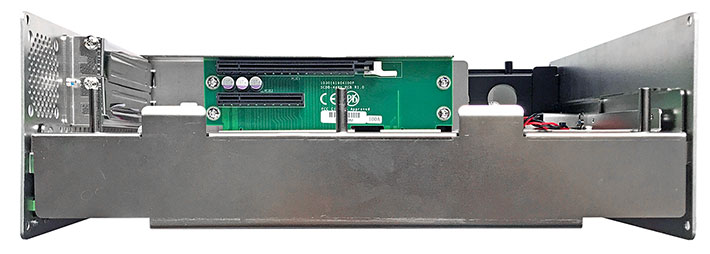
The two PCIe slots are of unequal length. The top slot can accommodate a PCIe x16 card, the bottom slot a PCIe x8 card via x4 lanes.The longer top slot is for half-length, full-height PCI expansion cards (which technically means cards up to about 180 mm long and up to 110 mm tall, but the FPC-9002 looks like it could fit a PCIe card as long as 260 mm).
Do note the significance of the PCIe x16 slot. This enables the addition of discrete graphics cards for applications that require high floating-point calculation performance or other GPU features not available in integrated graphics. The FPC-9002-P6's inherent smart fan thermal design with strategically positioned fans can easily dissipate the heat generated by any of the available processor options as well as that from discrete graphics solutions.
PCI and PCIe latency timer values can be set via the FPC-9002-P6 BIOS setup utility.
Summary: ARBOR Technology's FPC-9002-P6 Machine Vision Controller
With the FPC-9002-P6 Machine Vision Controller, ARBOR Technology offers a purpose-built version of its flexible and highly configurable FPC line of robust industrial Box PCs. Capable of providing 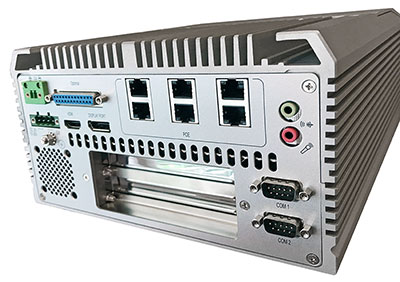 Power over Ethernet to six cameras, supporting three independent displays, and running cool all day long thanks to its Smart Fan control support, the FPC-9002-P6 represents an ideal COTS solution for numerous machine vision applications, more general factory applications, as well as use in autonomous vehicles. Power over Ethernet to six cameras, supporting three independent displays, and running cool all day long thanks to its Smart Fan control support, the FPC-9002-P6 represents an ideal COTS solution for numerous machine vision applications, more general factory applications, as well as use in autonomous vehicles.
Available with a variety of Intel 7th generation Core i3, Core i5, Core i7 "Kaby Lake" processors as well as a (6th gen) Xeon option, customers have access to a wide range of performance and features.
The rather compact (footprint roughly that of a standard 8-1/2 x 11 sheet of paper) FPC-9002-P6, using aluminum alloy over steel construction, also allows additional customization via two PCI/PCIe expansion slots and cards.
To see the entire lineup of ARBOR Technology's industrial automation systems, see click here.
| Status |
Added 08/2018, full review 08/2018
|
| Type |
Machine Vision Controller Box PC
|
| CPU Type |
Intel Core i7-7700T or
Intel Core i5-7500T or
Intel Core i3-7101TE or
Intel Xeon E3-1268L v5
|
| Chipset |
Intel C236
|
| OS |
Windows 10 IoT (for 7th gen Intel CPUs)
Windows 7 / Windows 8.1 / Windows 10 IoT (for 6th gen Intel CPUs)
Linux (Kernel 4.4.x)
|
| Memory |
Up to 32GB DDR4 2133MHz RAM in two 260-pin SO-DIMM sockets |
| Graphics Controller |
Intel HD Graphics 630 (Core processors) or Intel Graphics P530 (Xeon processor) |
| Watchdog Timer |
1-255 levels timer intervals, software setup |
| Graphics Interface |
1 x DisplayPort
1 x HDMI
1 x DVI-D (for digital video out)
1 x VGA (DB15 connector, for analog RGB)
|
| Storage |
2 x 600MB/s Serial ATA, one fixed-mount, one externally accessible. 1 x CFast. Dual configurations support RAID 0/1.
|
| Expansion |
2 x mini-PCIe card interconnected for optional WiFi/3G/4G/GPS or I/O Expansion; 1 x SIM card
1 x PCIe x16 slot + 1 x PCIe x8 slot (via x 4 lanes)
|
| Housing |
Steel chassis, aluminum alloy heat sink, wall mount
|
| Vibration |
3 Grms/5~500Hz/random operation w/ SSD
|
| Shock |
Operating 40G (11ms) with SSD
Non-operating 60G with SSD
|
| Operating temperature |
-4° to 131°F (-20° to °55C)
|
| USB |
6 x USB 3.0/2.0; optional internal USB dongle
|
| LAN |
6 x RJ45 for Power over Ethernet
3 x RJ45 for GbE
|
| Serial |
2 x RS-232/422/485 configurable via DB-9 connectors
|
| Audio |
1 x line-out, 1 x mic-in |
| Communication |
Optional dual-band Atheros AR9462 802.11a/b/g/n WiFi with Bluetooth 4.0 |
| DIO |
1 x DB25 connector for 1 x DIO (8 in/8 out) port or 1 x LPT port (either one)
|
| Size |
FPC-9002-P6: 8.86 x 11.50 x 4.72 inches (225 x 292 x 120mm)
|
| Weight |
FPC-9002-P6: 15.4 lb (7.2kg)
|
| Power |
DC 19~36V input (w/ 4-pin DC input terminal block, combining remote power on/off switch; 2-pin teminal block: IGN, GND
|
| Price |
Inquire |
| Webpage |
ARBOR FPC-9002-P6 web page
|
| Datasheet |
ARBOR FPC-9002-P6 web page
|
| Contact |
ARBOR Technology Headquarters
10F., No.700, Zhongzheng Rd.,
Zhonghe Dist., New Taipei City 235, Taiwan
Tel: 886 2 8226 9396
Fax: 886 2 8226 9398
Email: sales@arbor.com.tw
Web: www.arbor-technology.com
|
|




